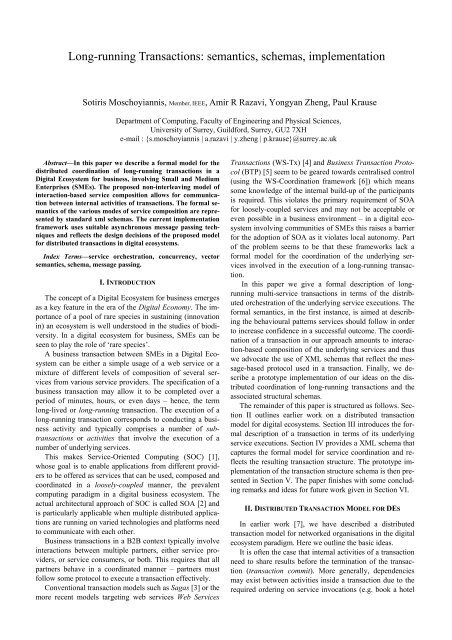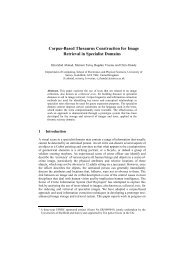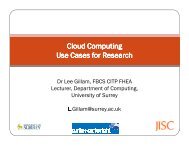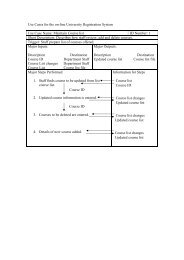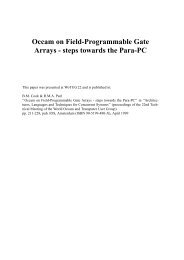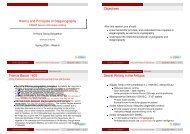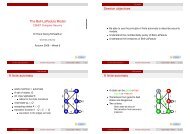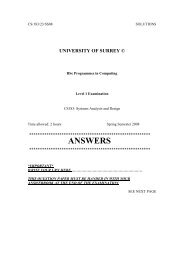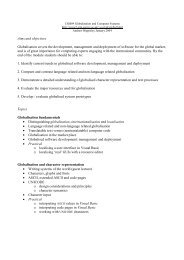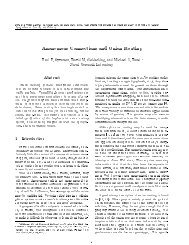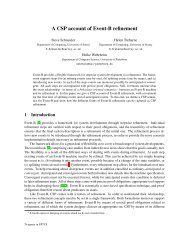Long-running Transactions - Department of Computing - University ...
Long-running Transactions - Department of Computing - University ...
Long-running Transactions - Department of Computing - University ...
You also want an ePaper? Increase the reach of your titles
YUMPU automatically turns print PDFs into web optimized ePapers that Google loves.
<strong>Long</strong>-<strong>running</strong> <strong>Transactions</strong>: semantics, schemas, implementationSotiris Moschoyiannis, Member, IEEE, Amir R Razavi, Yongyan Zheng, Paul Krause<strong>Department</strong> <strong>of</strong> <strong>Computing</strong>, Faculty <strong>of</strong> Engineering and Physical Sciences,<strong>University</strong> <strong>of</strong> Surrey, Guildford, Surrey, GU2 7XHe-mail : {s.moschoyiannis | a.razavi | y.zheng | p.krause}@surrey.ac.ukAbstract—In this paper we describe a formal model for thedistributed coordination <strong>of</strong> long-<strong>running</strong> transactions in aDigital Ecosystem for business, involving Small and MediumEnterprises (SMEs). The proposed non-interleaving model <strong>of</strong>interaction-based service composition allows for communicationbetween internal activities <strong>of</strong> transactions. The formal semantics<strong>of</strong> the various modes <strong>of</strong> service composition are representedby standard xml schemas. The current implementationframework uses suitable asynchronous message passing techniquesand reflects the design decisions <strong>of</strong> the proposed modelfor distributed transactions in digital ecosystems.Index Terms—service orchestration, concurrency, vectorsemantics, schema, message passing.I. INTRODUCTIONThe concept <strong>of</strong> a Digital Ecosystem for business emergesas a key feature in the era <strong>of</strong> the Digital Economy. The importance<strong>of</strong> a pool <strong>of</strong> rare species in sustaining (innovationin) an ecosystem is well understood in the studies <strong>of</strong> biodiversity.In a digital ecosystem for business, SMEs can beseen to play the role <strong>of</strong> ‘rare species’.A business transaction between SMEs in a Digital Ecosystemcan be either a simple usage <strong>of</strong> a web service or amixture <strong>of</strong> different levels <strong>of</strong> composition <strong>of</strong> several servicesfrom various service providers. The specification <strong>of</strong> abusiness transaction may allow it to be completed over aperiod <strong>of</strong> minutes, hours, or even days – hence, the termlong-lived or long-<strong>running</strong> transaction. The execution <strong>of</strong> along-<strong>running</strong> transaction corresponds to conducting a businessactivity and typically comprises a number <strong>of</strong> subtransactionsor activities that involve the execution <strong>of</strong> anumber <strong>of</strong> underlying services.This makes Service-Oriented <strong>Computing</strong> (SOC) [1],whose goal is to enable applications from different providersto be <strong>of</strong>fered as services that can be used, composed andcoordinated in a loosely-coupled manner, the prevalentcomputing paradigm in a digital business ecosystem. Theactual architectural approach <strong>of</strong> SOC is called SOA [2] andis particularly applicable when multiple distributed applicationsare <strong>running</strong> on varied technologies and platforms needto communicate with each other.Business transactions in a B2B context typically involveinteractions between multiple partners, either service providers,or service consumers, or both. This requires that allpartners behave in a coordinated manner – partners mustfollow some protocol to execute a transaction effectively.Conventional transaction models such as Sagas [3] or themore recent models targeting web services Web Services<strong>Transactions</strong> (WS-Tx) [4] and Business Transaction Protocol(BTP) [5] seem to be geared towards centralised control(using the WS-Coordination framework [6]) which meanssome knowledge <strong>of</strong> the internal build-up <strong>of</strong> the participantsis required. This violates the primary requirement <strong>of</strong> SOAfor loosely-coupled services and may not be acceptable oreven possible in a business environment – in a digital ecosysteminvolving communities <strong>of</strong> SMEs this raises a barrierfor the adoption <strong>of</strong> SOA as it violates local autonomy. Part<strong>of</strong> the problem seems to be that these frameworks lack aformal model for the coordination <strong>of</strong> the underlying servicesinvolved in the execution <strong>of</strong> a long-<strong>running</strong> transaction.In this paper we give a formal description <strong>of</strong> long<strong>running</strong>multi-service transactions in terms <strong>of</strong> the distributedorchestration <strong>of</strong> the underlying service executions. Theformal semantics, in the first instance, is aimed at describingthe behavioural patterns services should follow in orderto increase confidence in a successful outcome. The coordination<strong>of</strong> a transaction in our approach amounts to interaction-basedcomposition <strong>of</strong> the underlying services and thuswe advocate the use <strong>of</strong> XML schemas that reflect the message-basedprotocol used in a transaction. Finally, we describea prototype implementation <strong>of</strong> our ideas on the distributedcoordination <strong>of</strong> long-<strong>running</strong> transactions and theassociated structural schemas.The remainder <strong>of</strong> this paper is structured as follows. SectionII outlines earlier work on a distributed transactionmodel for digital ecosystems. Section III introduces the formaldescription <strong>of</strong> a transaction in terms <strong>of</strong> its underlyingservice executions. Section IV provides a XML schema thatcaptures the formal model for service coordination and reflectsthe resulting transaction structure. The prototype implementation<strong>of</strong> the transaction structure schema is then presentedin Section V. The paper finishes with some concludingremarks and ideas for future work given in Section VI.II. DISTRIBUTED TRANSACTION MODEL FOR DESIn earlier work [7], we have described a distributedtransaction model for networked organisations in the digitalecosystem paradigm. Here we outline the basic ideas.It is <strong>of</strong>ten the case that internal activities <strong>of</strong> a transactionneed to share results before the termination <strong>of</strong> the transaction(transaction commit). More generally, dependenciesmay exist between activities inside a transaction due to therequired ordering on service invocations (e.g. book a hotel
only after booking the flight) or due to the sharing <strong>of</strong> data(one uses the results <strong>of</strong> another). The use <strong>of</strong> log structures,given in the form <strong>of</strong> directed graphs, has been described in[7], [8] for capturing the internal and external dependencies<strong>of</strong> a transaction. The benefit <strong>of</strong> using these lightweight logsis that each platform coordinator only needs to have knowledgeabout its services and their dependencies to other coordinators’services – it needs to know only what happensbefore and after its own services. Due to space limitationswe omit further details.In our model a transaction is represented by a tree structurethat allows us for nested subtransactions and exemplifiesthe local coordination that is required for the servicesinvolved to be performed in unison.Drawing upon the latest work on an extended serviceorientedarchitecture for a business environment [2], wehave considered five different types <strong>of</strong> coordinators whichallow for various modes <strong>of</strong> service interaction in our model.In the transaction tree <strong>of</strong> Fig. 1, the services s3 and s4 forexample are children <strong>of</strong> a sequential coordinator and hences4 can only be executed after s3. In other words the execution<strong>of</strong> s4 is dependent on the (successful) execution <strong>of</strong> s3,e.g. s4 uses use the results released by s3.The DE nested transaction model can be represented in acontext schema. This is used by the Initiator <strong>of</strong> a transactionto specify the different levels <strong>of</strong> compositions <strong>of</strong> the underlyingservices. The schema also shows the boundaries andrequirements <strong>of</strong> the model and the need for a formal languageto describe transactions, which will be given in SectionIV. Fig. 2 shows such a schema (the Netbeans 5.5.1source can be found following [9]).The nested transaction structure is imposed in theschema using the ‘Coordinator’ element which can includea service composition (‘Composition’ element in theschema) or usage <strong>of</strong> a simple web service (‘WebService’)including a purely data-oriented web service (a leaf <strong>of</strong> thetree). Each service composition (‘Composition’) has a type(‘CompositionType’), which determine the mode <strong>of</strong> the interaction-basedcomposition (sequential, parallel or alternative).It has two or more ‘Coordinator’ elements which introducerecursion - another service composition or a simpleweb service. This recursive definition can generate an XMLrepresentation <strong>of</strong> the transaction tree. In the following sectionswe interpret this context schema into a formal languagewhich allows for an XML presentation <strong>of</strong> the semantics<strong>of</strong> a transaction can be implemented in different platforms.Fig. 2 Transaction Context SchemaIV. A FORMAL LANGUAGE FOR TRANSACTIONSFig. 1 <strong>Transactions</strong> in a tree structureThe scenario described in Fig. 1 has appeared in [7] andhas been simplified here, nevertheless the transaction inquestion is complicated enough to illustrate the key ideas <strong>of</strong>our formal modelling approach.III. TRANSACTION CONTEXT SCHEMAIn this section we introduce a formal language for describinglong-<strong>running</strong> transactions. Apart from the dependenciesbetween service executions, there is a high degree <strong>of</strong>concurrency in a transactional environment since real problemsrequire a number <strong>of</strong> activities to take place in parallel.For this reason we will find the general theory <strong>of</strong> noninterleavingrepresentation <strong>of</strong> parallel behaviour found in[10] <strong>of</strong> great use in what follows. As mentioned before, ourobjective is to get a thorough understanding <strong>of</strong> the behaviourthe underlying service compositions need to exhibit fora successful outcome <strong>of</strong> the transaction as a whole.The semantics is intended to describe the behaviour <strong>of</strong> atransaction in terms <strong>of</strong> its services at the deployment level,but not the low-level computations performed by the servicesthemselves. Note that services are <strong>of</strong>fered in a digitalecosystem for business from different service providers andit is important that we defer from interfering with the localstate <strong>of</strong> the service execution. This means it is appropriateto consider that any action within the transaction model hasno significant duration, in the sense that (i) it either occursas a whole or not at all; (ii) it occurs either wholly before,or wholly after, or wholly in parallel with, every other action.A transaction T is associated with a set <strong>of</strong> leaves or accesspoints L which consists <strong>of</strong> a set <strong>of</strong> basic services S, aset <strong>of</strong> data-oriented coordinators D and a set <strong>of</strong> delegationcoordinators Dlg. Hence, L = S ∪ D ∪ Dlg. We further requirethat the sets S, D and Dlg are pairwise disjoint.
Actions within a long-<strong>running</strong> transaction take place onthe leaves and therefore each leaf is in turn associated witha set <strong>of</strong> actions that may occur on that leaf, depending on itsnature. We denote this set by μ (l), l∈L, and require thatU μ (l) ⊆ M.l∈LAs can be seen in Fig. 1 a transaction has a number <strong>of</strong>activation points, namely the leaves <strong>of</strong> the correspondingtransaction tree. Thus, instead <strong>of</strong> modelling a transaction bya sequential process that would generate a trace <strong>of</strong> a singleaccess point, we model the behaviour <strong>of</strong> a transaction byconsidering a set <strong>of</strong> such sequences at the same time, onesequence for each leaf. This draws upon Shields’ vectorlanguages [9] and allows us to capture what is happeningon each access point <strong>of</strong> a long-<strong>running</strong> transaction.Transaction vectors. Let T be a transaction. We defineV T to be the set <strong>of</strong> all functions v: L → M* such thatv(l) ∈ μ (l)*.By μ (l)* we denote the set <strong>of</strong> finite sequences overμ (l). Mathematically, the set V T is the Cartesian product <strong>of</strong>the sets μ (l)*, for each l. Effectively, transaction vectorsare n-tuples <strong>of</strong> sequences where each coordinate correspondsto a leaf in the transaction tree (hence, n is the number<strong>of</strong> leaves) and contains a finite sequence <strong>of</strong> actions thathave occurred on that leaf or access point.When an action occurs on a leaf <strong>of</strong> the transaction tree,that is to say when an action associated with some subtransactiontakes place on an access point, it appears on a newtransaction vector and at the appropriate coordinate. For example,the vector (s 1 ,Λ, Λ) describes that portion <strong>of</strong> behaviour<strong>of</strong> the transaction in which an action s 1 (e.g. serviceinvocation) has taken place on the corresponding serviceallocated to the first coordinate. The vector (s 1 , s 2 , Λ) describesthat portion <strong>of</strong> behaviour in which both s 1 and s 2have happened on the corresponding services while the vector(s 1 s 3 , s 2 , Λ) describes an occurrence <strong>of</strong> s 1 and an occurrence<strong>of</strong> s 3 on the service corresponding to the first coordinate,and an occurrence <strong>of</strong> s 2 on the second coordinate.Nothing has happened on the service corresponding to thethird coordinate.In this sense, each transaction vector provides a snapshot<strong>of</strong> behaviour in which the transaction has executed theactions appearing on the vector’s coordinates – it describeswhat actions have already occurred and on which part <strong>of</strong> thetransaction tree. Fig. 3 shows the xml schema types forbuilding a single transaction vector. Each transaction vectorcomprises a specific number <strong>of</strong> ‘access points’ (five inour example), and each access point corresponds to a service,a data-oriented coordinators or a delegation coordinator,all presented as ‘DE-WebServices’ in our xml schema.Fig. 3 A single vector type (xml schema presentation)It can be seen from the example given above that thereis already an ordering among actions on a particular accesspoint or subtransaction, e.g. s 1 followed by s 3 . This vectorbasedbehavioural description <strong>of</strong> transactions can also capturethe orderings between different subtransactions, whichamounts to actions appearing on different vector coordinates.This requires however a more careful consideration<strong>of</strong> the mathematical properties <strong>of</strong> such vectors which webriefly describe in the sequel.Before examining the mathematical properties <strong>of</strong> ourconstruction so far, we introduce a specific kind <strong>of</strong> transactionvector, which is used in our model to describe actions(events or activations) within a transaction.Column vectors. Let T be a transaction and V T its set <strong>of</strong>transaction vectors. We defineAT= { a ∈VT\{ ΛT}: l ∈ L ⇒|a(l)| ≤ 1}where | x | denotes the length <strong>of</strong> sequence x. We refer toelements <strong>of</strong> A T as column vectors.Thus, column vectors are themselves transaction vectors,but have the additional constraint that each <strong>of</strong> their coordinatesis either the empty sequence or a single action.For example, the vector (s 1 ,Λ, Λ) represents the occurrence<strong>of</strong> an action s 1 on the service associated with the first coordinate.We will use the term transaction language to refer to asubset V <strong>of</strong> all possible vectors V T formed over a giventransaction T. Hence, a transaction T comes with a languageV, where V ⊆ V T . The idea is that the particular set <strong>of</strong> transactionvectors for a specific transaction expresses the orderingconstraints necessary in the corresponding service orchestration.We have seen that transaction vectors are essentially tuples<strong>of</strong> sequences. This can be exploited in defining operationson vectors in terms <strong>of</strong> well-known operations on sequences.Operations on vectors. For u, v ∈ VT , we define- u.v to be the unique vector w such that w(l) = u(l).v(l),for each l∈L (concatenation)- u ≤ v iff u(l) ≤ v(l), for each l∈L (prefix ordering)- glb(u,v) to be the vector w such that w(l)=min(u(l),v(l)),for each l∈L- lub(u,v) (if it exists) to be the vector w such thatw(l)=max(u(l),v(l)), for each l∈L- if u ≤ v, then we define v / u to be the unique elementz∈V T such that u.z = v (right-cancellation)Thus, the operation <strong>of</strong> concatenation on vectors is definedin terms <strong>of</strong> the concatenation <strong>of</strong> sequences appearingon their respective coordinates. For example,( s1s3, s2,Λ).(Λ,s4, Λ)= ( s1s3, s2s4, Λ)The ordering amongst vectors is defined in terms <strong>of</strong> theusual prefix ordering operation on sequences appearing ontheir coordinates. For example, (s 1 , s 2 , Λ) ≤ (s 1 s 3 , s 2 , Λ)since s 1 ≤ s 1 s 3 and s 2 ≤ s 2 and Λ ≤ Λ. In other words, thesecond vector ‘wins’ on the first coordinate (since it has asequence <strong>of</strong> greater length in this coordinate) while the twovectors draw on all other coordinates.It is not hard to see that some vectors will be incomparable.It turns out that such vectors describe either parallel
or alternative behaviours <strong>of</strong> the transaction in question, andthis will be further discussed in the following sections.The operations glb() and lub() give the greatest lowerbound and the least upper bound, respectively <strong>of</strong> u, v∈V T ,in the usual sense <strong>of</strong> lattices and domain theory [11]. As wewill see, these operations are central to the treatment <strong>of</strong> concurrencyin our approach.The right cancellation operator ‘/’ says that if u is atransaction vector describing an initial part <strong>of</strong> the behaviourdescribed by v so that u ≤ v, then v / u is the ‘continuation’<strong>of</strong> u that extends it to v. This operation is central to thetreatment <strong>of</strong> compensations in our approach. We return tothis discussion in the concluding section <strong>of</strong> the paper.It is important to stress the fact that all operations onvectors are performed coordinate-wise and this simplifiesthe pro<strong>of</strong>s but also makes the formal model feasible for implementation.Transaction vectors can be seen to be built up from theempty vector Λ Τ by a series <strong>of</strong> concatenations with columnvectors that represent actions. In fact, in describing the behaviour<strong>of</strong> a transaction we are interested only in those vectorsdescribing (orderings <strong>of</strong>) actions that we expect thetransaction to engage in during the course <strong>of</strong> its execution.This is the subset <strong>of</strong> all possible transaction vectors, over agiven T, we referred to as transaction language.A. Sequential service compositionsThe prefix ordering relation on transaction vectors canbe viewed as an ordering on partial executions, where eachvector corresponds to that portion <strong>of</strong> behaviour in which thetransaction has already engaged in the actions appearing onits coordinates. This can be expressed more succinctly bysaying that u ≤ v in a transaction language means that u isan earlier part <strong>of</strong> behaviour leading to v.A more careful examination <strong>of</strong> the mathematical constructionshows that we can say more than that. Indeed, wefind it useful to determine immediate predecessors (or successors)<strong>of</strong> a transaction vector.Cover. Suppose that u, v ∈V ⊆ V T . We say that v coversu in V, and we write u< Vv, if (i) u ≤ v and u ≠ v and(ii) If z∈V such that u ≤ z ≤ v, then z = u ∨ z = v.Thus, whenever u ≤ v, and we also have that u < v,then the last actions that went into forming each vector haveoccurred in sequence - one after the other. This allows tomodel sequential dependency among services inside a transaction.Recall the example <strong>of</strong> Fig. 1 where service s 3 feedsservice s 4 .Fig. 4 presents the corresponding schema for sequentialservice composition. The ‘TransactionVectors-Type’ has aTransactionVector element which includes a single transactionvector (e.g. describing the service invocation s 3 ) andthe immediate successor (describing the service invocations 4 ). The latter is captured by the ‘FollowedBy’ element. Thetype <strong>of</strong> ‘SequentialComposition’ simply includes a singletransaction vector followed by another transaction vector.Fig. 4 Sequential service composition (xml schema presentation)B. Parallel service compositionsOur approach towards modelling concurrent actions, actionsthat can happen in parallel, draws upon the concepts inShields’ vector languages [10] and Mazurkiewicz tracelanguages [12] where concurrent events are considered asbeing unordered, in contrast to CSP trace theory where it isassumed that observations are sequential in nature and concurrentevents are understood to occur in either order (nondeterministicinterleaving).The treatment <strong>of</strong> concurrency within our formal model<strong>of</strong> transactions thus takes up on non-interleaving models <strong>of</strong>concurrency, which introduce additional structure into formallanguages in order to describe non-sequential behaviour.The additional structure is given in terms <strong>of</strong> an independencerelation over action symbols, which describes potentialconcurrency.Drawing upon the extension <strong>of</strong> the independence relationι to behaviour vectors in [9], the notion <strong>of</strong> independencebetween actions in Mazurkiewicz traces can be readilyinterpreted into transaction vectors in our approach.Independence. For u, v ∈V ⊆ V T , we defineu ind v ⇔ ∀ l ∈L : u(l) > Λ ⇒ v(l) = ΛThis definition says that two transaction vectors are independentif the behaviours they describe concern distinctservices (correspond to activation on different leaves <strong>of</strong> thecorresponding transaction tree). This means that the behavioursdescribed by u and v may occur independently.In the case <strong>of</strong> column vectors, independence capturesthe fact that actions appearing in one vector may occur independently<strong>of</strong> those appearing in the other. If in additionthe vectors representing these actions are adjacent in an expression(<strong>of</strong> the series <strong>of</strong> concatenations that went int<strong>of</strong>orming the corresponding transaction vectors), then the actionsare concurrent. Thus, whenever two actions are independentand are both enabled (can both occur at some point,after some behaviour) then, their corresponding columnvectors commute, i.e. a 1 .a 2 = a 2 .a 1 , and in the resulting behaviourthe two actions are concurrent.The parallel service composition schema is depicted inFig. 5. A ‘ParallelComposition’ consists <strong>of</strong> two or more (up
to the number <strong>of</strong> its access points, in this example 5) transactionvectors, followed by a ‘TransactionVectors-Type’,which imposes that all transaction vectors describing parallelexecutions have one immediate successor (their lub()identified in the schema by the ‘FollowedBy’ element) andthe concurrent service invocations can happen on differentaccess points (recall the independence relation - two actionsare independent, and potentially concurrent, if they engagedifferent access points).Fig. 5 Parallel service composition (xml schema presentation)C. Alternative service compositionsBased on the prefix ordering between transaction vectorsin the set V we may also model a choice between actions.That is, actions which are mutually exclusive in thatoccurrence <strong>of</strong> one excludes occurrence <strong>of</strong> the other.In discussing concurrent actions in a long-<strong>running</strong> transaction,we saw that the two incomparable transaction vectorsrepresent concurrent behaviour. The vector they bothcover is in fact their greatest lower bound and is obtainedby applying the operation glb() given earlier. The fact thetwo incomparable vectors represent concurrent actions isonly because they are bounded above in the set (by thetransaction vector which is their lub() and is sitting on top<strong>of</strong> the lozenge). Whenever this latter requirement does nothold we may talk about events in conflict.It might be instructive to make the distinction in terms<strong>of</strong> pictures and associated Hasse diagrams. In the diagram<strong>of</strong> Fig. 1, s 1 and s 2 are sequential (s 2 can only be invokedafter s1) in Fig.6(i) while there is a choice between them(alternative) in Fig.6(ii) and they are concurrent inFig.6(iii).Fig. 6 Order structure <strong>of</strong> transaction vectorsNotice that the set <strong>of</strong> vectors in (i) does not include ( Λ ,s 2 , Λ ), which means that s 2 never occurs before s 1 ; in (ii) itdoes not include (s 1 , s 2 , Λ ) which means there is no validbehaviour <strong>of</strong> the transaction processing system in whichboth s 1 and s 2 have taken place; in (iii) it includes all fourvectors, which means that s 1 , s 2 and both s 1 and s 2 are allvalid observations <strong>of</strong> the behaviour <strong>of</strong> the transaction systemin which s 1 and s 2 happened concurrently. This is indicatedby the familiar lozenge shape that exhibits the characteristicstructure <strong>of</strong> a finite lattice.In further explanation, the vector sitting at the bottom <strong>of</strong>the lozenge is the glb() <strong>of</strong> the two incomparable vectors(s 1 , Λ , Λ ) and ( Λ , s 2 , Λ ) sitting at the middle <strong>of</strong> the lozengerepresent while the vector at the top is their lub(). Thelozenge as a whole describes that part <strong>of</strong> behaviour <strong>of</strong> thetransaction in which s 1 and s 2 happened concurrently, as indicatedby the vector at its top. Further details on how theordering relations between actions are manifested in the resultingorder structure <strong>of</strong> the resulting set <strong>of</strong> vectors can befound in [13].Fig. 7 presents the alternative service compositionschema. An ‘AlternativeComposition’ consists <strong>of</strong> two ormore (up to the number <strong>of</strong> its access points, here 5) alternativetransaction vectors. Notice that in this case there is no‘FollowedBy’ element as vectors describing alterantive servicedeployment do not lead to a common vector, i.e. do nothave a lub() in the formal language.Fig. 7. Alternative service composition (xml schema presentation)V. IMPLEMENTATIONWe have used JAX-WS 2.1, Java 5, and Netbeans IDE5.5.1 in our implementation framework. The JAX-WS is anew standard for message passing, it supports both synchronousand asynchronous message passing by the pollingmodel and the call-back model, respectively. In the pollingmodel, the client continuously polls the service response. Inthe call-back model, the client creates a call-back handler.JAX-WS is shown to perform better than JAX-RPC in certainaspects [14]. Furthermore, JAX-WS supports static anddynamic generation <strong>of</strong> web service client stubs.In our implementation, the JAX-WS call-back messagepassing and dynamic client stub generation are used. Thecall-back message passing is suitable for asynchronousmessage passing, which is important for long term transactions.The dynamic WS client creation enables web serviceinvocation chains. Three participants are required in orderto make a service X work: 1) X web service; 2) X TransactionAgentweb service; 3) the client stubs for the X web service.The dependencies between web services are capturedin a XML file, as discussed before.From the transaction vector schema, we can create differenttransaction scenarios (as xml file). The generated xmlfile shows the various states <strong>of</strong> a transaction for a specificscenario. We have designed a s<strong>of</strong>tware agent coordinatorwhich can perform the transaction vector in fully distributedmanner. As a case study we analyse a simple transaction,with a sequential service composition, which involves theinteractions shown in the Sequence diagram <strong>of</strong> Fig. 8.
Fig. 8 A simple transaction with a sequential service compositionOur simple transaction scenario involves two participants,located at two different SMEs (Hotel and Taxi services).The initiator agent has an AgentHelper that communicateswith the TransactionAgents. The transaction involvesfour players: HotelTransactionAgent (HTA; localcoordinator <strong>of</strong> the Hotel), HotelService (webservice <strong>of</strong> thehotel), TaxiTransactionAgent (TTA; local coordinator <strong>of</strong>taxi), and TaxiService (webservice <strong>of</strong> the taxi). TheAgentHelper plays the Initiator role and it starrts the transactionby sending messages (setting the transaction context)to both HTA and TTA. This specifies the first web serviceshould be deployed on the first access point (HTA) and thesecond will be deployed only after receiving the successfulconfirmation <strong>of</strong> the first (sequential service composition).The following information about the required distributedcoordination can be derived: 1) the AgentHelper will knowthat after it initiates the HTA and TTA, it needs to wait for aresponse from the TTA for the final preparation status; 2)the HTA will know that it depends on TTA so it needs tosend a message to TTA asking for final preparation status;3) the TTA will know that it gets a request message fromthe HTA and then sends its response message back to theAgentHelper for the final preparation status. Fig 9 showsthe performance analysis <strong>of</strong> the case study in terms <strong>of</strong> CPUperformance, memory usage, and thread usage when theclient performs a commit transaction. The Netbeans 5.5.1source is available following [9].Fig. 9 Run time behaviour <strong>of</strong> the scenarioVI. CONCLUSIONS AND FUTURE WORKWe have described an integrated view <strong>of</strong> various aspects<strong>of</strong> a transaction model for digital ecosystems for business.To harness the complexity in this highly dynamic environmentand increase confidence in a successful outcome, athorough understanding <strong>of</strong> the underlying service executionsand their dependencies is essential. This has beengiven by a formal model that can be represented by standardxml schemas and be used to guide the implementation.We laid the foundations for the formal modelling <strong>of</strong>long-<strong>running</strong> transactions in terms <strong>of</strong> the underlying serviceexecutions which are orchestrated locally. The trueconcurrentformal semantics allows internal activities <strong>of</strong> atransaction to communicate and can capture parallelism,unlike other approaches [15]. An extension to address partialresults (released outside a transaction), based on [16],and compensating actions is currently under investigation atboth the modelling and implementation levels. Preliminaryresults [17] are encouraging.The current implementation framework is independent <strong>of</strong>the underlying network supporting the transactions. Work isin progress on integrating the implementation for the transactionmodel with the P2P network [17].Acknowledgements:This work was supported by the EU-FP6 funded project OPAALS ContractNo 034824.VII. REFERENCES[1] M. P. Papazoglou. Service-Oriented <strong>Computing</strong>: Concepts, Characteristicsand Directions. In Proc. WISE’03, IEEE, pp. 3-12, 2003.[2] M. P. Papazoglou, P. Traverso, S. Dustdar et al. Service-Oriented<strong>Computing</strong> Roadmap. In Dagstuhl Seminar Proc. 05462, Service-Orienrted <strong>Computing</strong> (SOC), pp. 1-29, 2006.[3] H. Garcia-Molina and K. Salem. Sagas. In ACM SIGMOD, pp. 249-259, 1987.[4] L.F. Cabrera, G. Copeland, J. Johnson and D. Langworthy. CoordinatingWeb Services Activities with WS-Coordination, WS-AtomicTransaction, and WS-BusinessActivity. January 2004. Available:http://msdn.micros<strong>of</strong>t.com/webservices/default.aspx[5] L.F. Cabrera, G. Copeland, W. Cox et al. Web Services Business ActivityFramework (WS-BusinessActivity). August 2005. Availablehttp://www128.ibm.com/developerworks/webservices[6] L.F. Cabrera, G. Copeland, M. Feingold et al. Web Services Coordination(WS-Coordination). August 2005. Available http://www-128.ibm.com/developerworks/webservices/library/specification/ws-tx[7] A. Razavi, S. Moschoyiannis, P. Krause. A Coordination Model forDistributed <strong>Transactions</strong> in Digital Ecosystems. In IEEE Digital Ecosystemsand Technologies (IEEE-DEST’07), 2007.[8] A. Razavi, P. J .Krause and S. K. Moschoyiannis. Digital BusinessEcosystem (DBE) Project Deliverable D24.5: DBE Distributed TransactionModel, 2006.[9] http://www.computing.surrey.ac.uk/personal/st/S.Moschoyiannis[10] M. W. Shields. Semantics <strong>of</strong> Parallelism. Springer-Verlag, 1997.[11] B.A. Davey and H.A. Priestley. Introduction to Lattices and Order,Cambridge <strong>University</strong> Press, 1990.[12] A. Mazurkiewicz. Basic Notions <strong>of</strong> Trace Theory. In Linear time,Branching Time and Partial Orders in Logics and Models <strong>of</strong> Concurrency,LNCS, 354, pp. 285-363, Springer, 1988.[13] S. Moschoyiannis. Specification and Analysis <strong>of</strong> Component-BasedS<strong>of</strong>tware in a True-Concurrent Setting. PhD Thesis, UniS, 2005.[14] http://java.sun.com/developer/technicalArticles/WebServices/high_performance/[15] M. Butler, A.C.R. Hoare, C. Ferreira. Trace Semantics for <strong>Long</strong>-Running <strong>Transactions</strong>. In 25 Years <strong>of</strong> CSP, LNCS 3525, pp. 133-150,2005[16] S.Moschoyianis, M.W. Shields. A Set-Theoretic Framework forComposition. Fundamenta Informaticae 59(4):373-396, 2004.[17] A. Razavi, S. Moschoyiannis and P. J. Krause "Preliminary Architecturefor Autopoietic P2P Network focusing on Hierarchical Super-Peers, Birth and Growth Models." OPAALS project DeliverableD3.2, 2007 - available at: http://files.opaals.org/OPAALS


